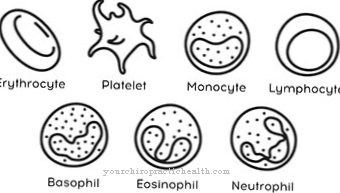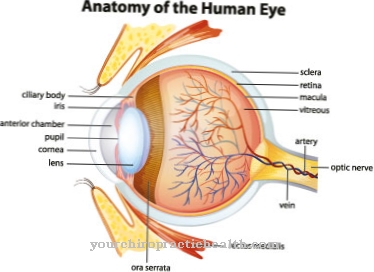What is meadow grass dermatitis?
A Meadow grass dermatitis is an inflammatory skin disease and occurs mainly in spring to autumn. It mainly affects people who have a lot to do with plants or who are often exposed to the sun. These include, for example, farmers or gardeners, but also children who are often in the fresh air.
causes
Meadow grass dermatitis results in a phototoxic skin reaction that is triggered by certain plant substances and UV light. These substances come mainly from so-called psoralens, which can be found in fruit stands, stems and leaves of exotic or domestic plants.
These include celery (Apium graveolens), cartilage carrot, bergamot (Citrus bergamia), rue (Ruta gravedens), fig tree (Ficus carica) and angelica (Angelica). Masterwort (Peucedanum ostruthium), hogweed (Heracleum sphondylium), Hercules shrub (Heracleum montegazzianum) and parsnip (Pastinaca) also promote inflammation of the skin.
Some of the plants mentioned are also used for perfumes, spices or drinks, so that such a phototoxic reaction can also be triggered. Meadow grass dermatitis can also be caused by the following drugs: alendronate, special non-steroidal anti-inflammatory drugs, tetracyclines, phenothiazines and 3,5- or 8-methoxypsorals.
Meadow grass dermatitis can also be caused by cosmetics, tars or acridine dyes. Photodermatitis is not caused by an allergy, so it can occur in any person. Damp skin also favors its development. The plant substances that trigger meadow grass dermatitis are so-called photosensitizers.
These substances can absorb UV light and transfer the energy that is generated to the skin. While there is a radiation overdose in the case of sunburn, in the case of phototoxic reactions a UV dose that is within the tolerance range leads to dermatitis.
Symptoms, ailments & signs
After contact with the plants, skin changes appear after about one to two days that have a leaf-like, reticulate or streaky appearance. Because of the delayed appearance of the symptoms, the trigger is often not recognized by those affected. Blisters form, the skin is red and itchy. In addition, the patients often complain of burning pain.
Superinfection can also occur when the skin barrier is damaged. If the light exposure is only very weak after contact with the photosensitizers, then meadow grass dermatitis often proceeds without an inflammatory phase. This form is known as photodermatitis pigmentaria. After about two to four weeks, the skin changes heal with severe hyperpigmentation.
In the case of photodermatitis due to cosmetics, hyperpigmentation often appears in the form of a droplet falling down. The skin pigmentation often only disappears after a few months and can be cosmetically disturbing. Phototoxic reactions follow a certain distribution pattern, with the skin changes occurring specifically in exposed skin areas. The most common areas of skin affected are legs and arms.
If the dermatitis is triggered by cosmetics, skin changes can also occur on the décolleté, neck and face. Sometimes it is relatively difficult to differentiate it from so-called airborne contact dermatitis, which is triggered by plant allergens. Certain photosensitizers such as chlorpromazine or coal tar often cause an immediate reaction with urticarial erythema, burning and stinging.
Diagnosis & course of disease
The doctor makes the diagnosis based on the shape of the skin symptoms. Due to the bubbles that appear, which often have very bizarre patterns, meadow grass dermatitis can also be differentiated from sunburn. If necessary, the doctor can also detect the photosensitizer by means of a photo patch test. In a photopatch test, the doctor applies test substances to a plaster and applies it to the patient's back.
After one day, one side of it is removed and exposure to UV light takes place. After two days, the doctor also takes off the other test patch and marks both areas with a pen. These areas are then assessed for vesicles, papules and redness.
Complications
With meadow grass dermatitis, those affected primarily suffer from various skin complaints. These complaints have a very negative effect on the aesthetics of the person concerned and can therefore also lead to inferiority complexes or to a significantly reduced self-esteem. Children in particular suffer from depression or other psychological complaints, as they are often teased or bullied.
Due to meadow grass dermatitis, those affected suffer from severe itching and blisters on the skin. The skin itself is clearly reddened and can also burn or pain. Especially at night, this pain can lead to sleep problems and thus irritation in the patient. The patient's quality of life is significantly reduced by the disease.
Furthermore, there is very strong pigmentation, which is also cosmetically disruptive. The symptoms can be very uncomfortable, especially in the face. Meadow grass dermatitis is treated with the help of creams and ointments and in most cases leads to a positive course of the disease. As long as the person concerned avoids contact with the triggering substance, there are usually no particular complaints. The life expectancy of the person affected is not negatively affected by the disease.
When should you go to the doctor?
If the appearance of the skin changes or there are special health conditions while staying outdoors, a doctor should be consulted to clarify the symptoms. In many cases, the abnormalities show up around one to two days after contact with plants. Medical tests are needed to make a diagnosis, so a doctor should be consulted. If there is pain, blisters or reddening of the skin, action must be taken. Any itching, general malaise or a feeling of illness should also be examined and discussed with a doctor.
Sleep problems, concentration disorders and behavioral problems indicate a health irregularity that needs to be clarified. Withdrawal from social life, mood swings, reduced well-being and the assessment of a reduced quality of life are signs of a health disorder. So that the symptoms can be alleviated and the joy of life can be improved, the cause and a treatment plan must be clarified.
If the itching results in open wounds, complications can arise. If these are not taken care of professionally, sepsis and thus a potential danger to human life can occur. Therefore, if existing irregularities increase in size and intensity, a doctor should be consulted. Dry skin and tension in the skin are also to be interpreted as a warning signal for the organism and should be treated accordingly.
Therapy & Treatment
Meadow grass dermatitis is treated locally with lotions and creams that contain glucocorticoids. Very severe photodermatitis is treated like a second degree burn. To do this, the doctor punctures, cleans and disinfects the larger blisters and then protects them with a wound pad.
It also cools the redness like sunburn. Drugs and cosmetics with a phototoxic effect must be discontinued immediately. Severe depigmentation can be achieved with a combination of hydrocortisone 1 percent, hydroquinone 5.0 percent and vitamin A acid 0.1 percent. If permanent hyperpigmentation occurs, laser therapy can help.
Patients should also avoid contact with the triggering plant substance. Furthermore, direct sunlight should be avoided for a few days. For very severe forms, the doctor often prescribes cortisone for oral use or as an infusion.
You can find your medication here
➔ Medicines against redness and eczemaprevention
You can protect yourself from meadow grass dermatitis by wearing clothes that cover your legs and arms and thus prevent contact with plants. You should be particularly careful if you sweat heavily or after bathing, as the skin is moist and the effect of the plant substances is increased.
Shadows or a cloudy sky, on the other hand, do not protect against meadow grass dermatitis, as there is still enough ultraviolet light to cause the skin disease.
Aftercare
Meadow grass dermatitis is an allergic disease. Those affected should inform themselves comprehensively about the clinical picture and know the circumstances under which the health impairments can occur. The attending physician can use medical tests to find out which plant substances the person concerned is reacting to.
The patient should know plant locations and growing times to minimize personal risk. In order to act preventively, certain regions can of course be avoided. Before traveling, it is helpful to find out about the corresponding vegetation in the holiday area in order to prepare adequately.
Exposure to UV radiation generally increases the symptoms of meadow grass dermatitis and can cause further complications. Therefore, sunlight should be avoided as far as possible the first time skin irregularities appear. When leaving the house, make sure to cover your body with appropriate clothing as much as possible.
After spending a long time outdoors, it is advisable to change clothes in order to keep the pollen content in the air as low as possible. It is also important to carry the medically prescribed medication with you during the growth and flowering period so that you can act directly if necessary. A diet rich in vitamins is very important to prevent allergies. Vitamin C in particular, found in peppers, savoy cabbage, kale and fennel, helps the body protect itself from allergies.
You can do that yourself
People with meadow grass dermatitis should find out how to deal with the disease. It is important that they find out sufficiently under what circumstances the health disorders occur and what effects their own behavior has.
Various tests are used to find out which plant substances the person affected is reacting to. It is important to have biological and geographical knowledge in order to find out the locations and growth times of the relevant plants at an early stage. In many cases, after a certain period of time, sufficient knowledge is acquired about where the triggering plants are in everyday life. The region is avoided so that preventive action is taken. Before starting a trip or visiting another area, the person concerned should also try to get information about the fauna there.
If the first irregularities occur, sunlight should be avoided. The effect of UV radiation increases symptoms and can lead to further complications. It is therefore important to ensure that clothing is worn when leaving the house that covers the body as well as possible. At the beginning of the natural growth and flowering period, the medicine prescribed by the doctor must be carried with you as a precaution. Studies have shown that a balanced diet rich in vitamins also has a positive effect on further developments. Above all, care should be taken to ensure a sufficient supply of vitamin A.

.jpg)






.jpg)



















